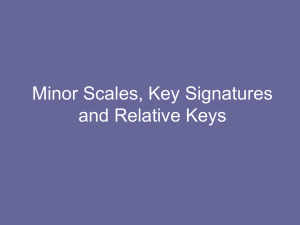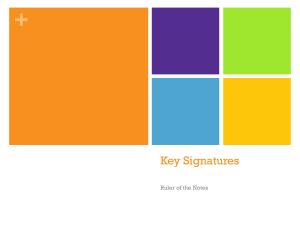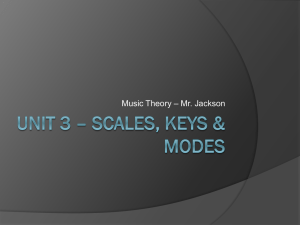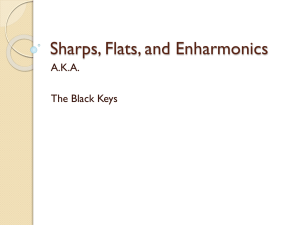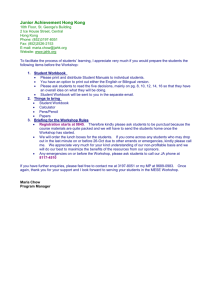Intro Mus Th
advertisement
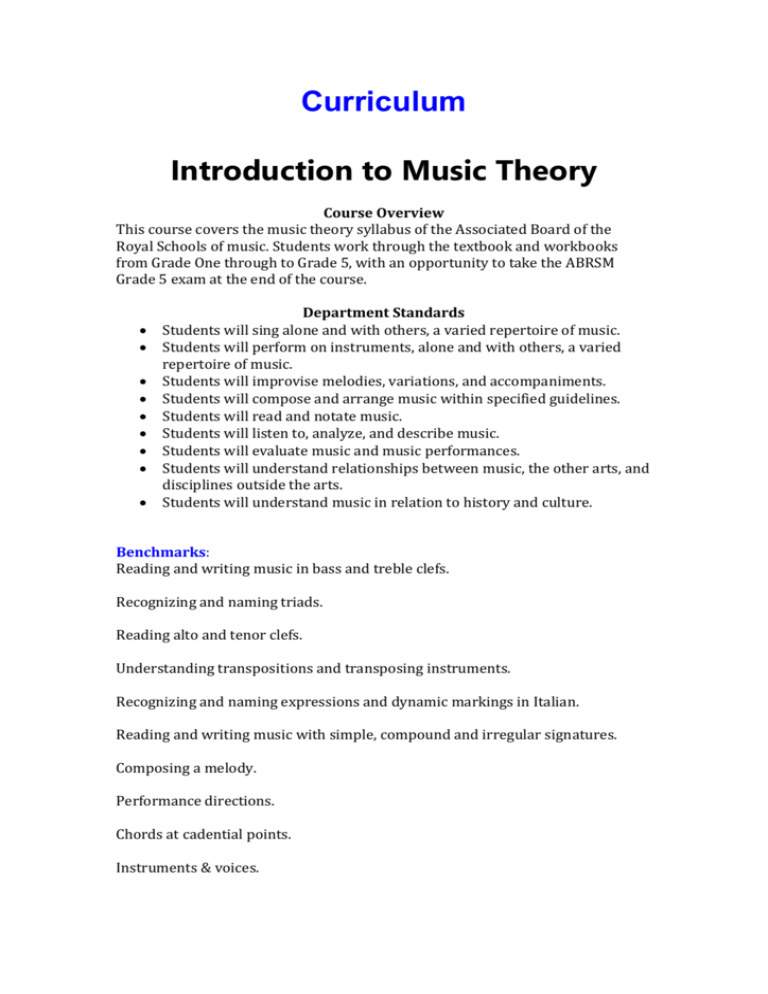
Curriculum Introduction to Music Theory Course Overview This course covers the music theory syllabus of the Associated Board of the Royal Schools of music. Students work through the textbook and workbooks from Grade One through to Grade 5, with an opportunity to take the ABRSM Grade 5 exam at the end of the course. Department Standards Students will sing alone and with others, a varied repertoire of music. Students will perform on instruments, alone and with others, a varied repertoire of music. Students will improvise melodies, variations, and accompaniments. Students will compose and arrange music within specified guidelines. Students will read and notate music. Students will listen to, analyze, and describe music. Students will evaluate music and music performances. Students will understand relationships between music, the other arts, and disciplines outside the arts. Students will understand music in relation to history and culture. Benchmarks: Reading and writing music in bass and treble clefs. Recognizing and naming triads. Reading alto and tenor clefs. Understanding transpositions and transposing instruments. Recognizing and naming expressions and dynamic markings in Italian. Reading and writing music with simple, compound and irregular signatures. Composing a melody. Performance directions. Chords at cadential points. Instruments & voices. Voices in score. Ornaments. Writing and recognizing all major and minor scales up to six sharps and flats. Naming and using key signatures, including majors and relative minors. Naming intervals. Updated 04/01/16 Performance Indicators Students will be able to: Name time signatures Draw whole, half, quarter and eighth notes on the staff Draw treble and bass clefs Draw rests Complete bars using notes and rests Use dotted notes and rests to complete bars Name and write tomes and semitones Name major key signatures Name and use accidentals Construct tonic triads Compose answering two-bar rhythms Students will be able to: Write and name ledger lines Demonstrate understanding of time signatures listed above Construct the scales listed above Recognize key signatures of scales as listed above Write and use triplets Write notes and rests in correct groupings with correct stem directions Compose simple four-bar rhythms Define performance directions (e.g. presto, maestoso, simile, etc.) Name rhythmic values up to demisemiquavers Write and use major and minor scales up to four sharps and flats Name and use notes with more than two ledger lines above and below both treble and bass clefs Transpose notes up and down one octave Write and use rhythms in compound time Recognize compound duple and compound triple meter Write simple time melodies in compound time Demonstrate understanding of correct groupings of notes and rests in compound time Recognize and use anacrusis Name intervals of up to an octave with major, minor and perfect classifications Compose musical phrases with given beginnings Construct triads on the tonic, subdominant and dominant Recognize turns, mordents, acciaccatura and appoggiatura Recognize irregular time-signatures Write and name notes in tenor clef Write scales enharmonically up to 6 sharps and flats Transpose a single-line passage from treble to tenor, alto and bass clef Transpose a single-line melody up or down by a stated interval (major 2nd, minor 3rd, etc.) Transcribe SATB extracts from short to open score and vice versa Name and write compound intervals up to a perfect 15th Name chords with Roman numerals and name their inversions use letters or numbers to identify the inversion Compose an eight-bar melody given a four-bar beginning, written for a stated instrument Rewrite passages using ornaments to replace notes Setting a melody to words Construct chords at cadential points Name the appropriate clef for all orchestral instruments Updated 04/01/16 Assessments ABRSM Grade 1 Workbook Grade 1 Exam Grade 2 Workbook Grade 2 Exam Grade 3 Workbook Grade 3 Exam Grade 4 Workbook Grade 4 Workbook Grade 4 Exam Grade 5 Workbook Grade 5 Exam Regular related Quizzes Updated 04/01/16 Core Topics Note Values Simple Time Signatures The Stave: G Clef and F clef The Major Scale Terms and Sign Ledger Lines Time Signatures: 2/2, 3/2, 4/2,3/8 Major Keys up to six sharps and flats Triplets Minor Keys up to six sharps and flats Grouping of notes and rests Intervals Composing simple four-bar rhythms Demisemiquavers (32nd notes) Beyond two ledger lines Transposition Compound time Minor Keys with four sharps or flats Grouping notes and rests in compound time Scales and key signatures Four-bar rhythms Phrase structures Alto Clef Double sharps and flats Breves, double dots and duplets Keys with five sharps or flats Triads in root position on tonic, subdominant and dominant notes Technical names of notes in diatonic scales Four-bar rhythms Triads and chords on i, iV and V Writing a rhythm to words The Chromatic Scale Ornaments Instruments Irregular time signatures Tenor Clef Major and minor keys up to six sharps Voices in a score Naming chords Composing a melody Chords at cadential points Updated 04/01/16 Specific Content Note values of semibreve, minim, crotchet, quaver and semiquaver,and their equivalent rests Tied notes Single-dotted notes and rests Simple time signatures, bar-lines and the grouping of the notes listed above within these times Composition of a two-bar rhythm in answer to a given rhythm starting on the •rst beat of a bar. Treble (G) and bass (F) clefs. Names of notes on the stave, including middle C in both clefs. Sharp, •at and natural signs, and their cancellations Construction of the major scale, including the position of the tones and semitones. Scales and key signatures of the major keys of C, G, D and F in both clefs, with their tonic triads (root position), degrees (number only), and intervals above the tonic (by number only) Some frequently used terms and signs concerning tempo, dynamics, performance directions and articulation marks88 Simple time signatures of 2/2,3/2,4/2,3/8 and the grouping of notes and rests within these times Triplets, and triplet note groups with rests Composition of simple four-bar rhythms starting on the first beat of the bar and using a given opening Extension of the stave to include two ledger lines below and above each stave. Construction of the minor scale (harmonic or melodic) Scales and key signatures of the major keys of A, Bb and Eb, and the minor keys of A, E and D, with their tonic triads (root position), degrees (number only), and intervals above the tonic (by number only) More terms and signs in common use Compound time signatures of 6/8,9/8 and 12/8 and the grouping of notes and rests within these times The demisemiquaver (32nd note) and its equivalent rest The composition of a simple four-bar rhythm which may start on an up-beat Extension of the stave beyond two ledger lines The transposition of a simple melody from the treble clef to the bass clef, or vice versa, at the octave Scales and key signatures of all major and minor keys up to and including four sharps and flats, including both harmonic and melodic forms of minor scales, with their tonic triads (root position), degrees (number only), and intervals above the tonic (number and type) More terms and signs Irregular time signatures of 5/4, 7/4,5/8,7/8 and the grouping of notes and rests within these times. Irregular divisions of simple time values. Tenor clef (C clef centred on 4th line). The identification of notes in the four clefs in any of the keys set for the grade, and the transposition at the octave of a simple melody from any clef to another. The writing at concert pitch of a melody notated for an instrument in Bb, A or F, and vice versa. The writing in open score, using treble and bass clefs, of a passage for SATB written on two staves, and vice versa. Scales and key signatures of all major and minor keys up to and including six sharps and flats. All simple and compound intervals from any note. The identification of the 5-3, 6-3, and 6-4 forms of the tonic, supertonic, subdominant and dominant chords in any of the keys set for this grade. The identification of the progression 6-4, 5-3 (Ic-V) on the dominant note in any of the keys set for this grade. The choice of suitable chords, using any recognized method of notation,at cadential points of a simple melody in the major key of C, G, D or F. The composition of a simple melody of not more than eight bars, using a given opening and writing for a specific instrument or the composition of a melody to given words. More terms and signs: the recognition of ornaments, including the replacement of written-out ornamentation with the appropriate signs, but not vice versa. Resources The AB Guide to Music Theory Part 1 Grade 1 Theory in Practice Workbook Grade 1 Theory Exam Grade 2 Theory in Practice Workbook Grade 2 Theory Exam Grade 3 Theory in Practice Workbook Grade 3 Theory Exam Grade 4 Theory in Practice Workbook Grade 4 Theory Exam Grade 5 Theory in Practice Workbook Grade 5 Theory Exam
